River Flow Alterations Caused by Intense Anthropogenic Uses and Future Climate Variability Implications in the Balkans
Abstract
1. Introduction
2. Study Area and Data
2.1. Study Area
2.2. Data
2.2.1. Streamflow Conditions Derived from the Hydrologic Catchment Model PANTA RHEI
2.2.2. Streamflow Conditions Impacted by Climate Variability/Change
3. Methodology
3.1. Hydrological Methods for Environmental Flow Assessment
3.2. Climate Variability/Change Impact on Flow Regime
4. Results
4.1. Descriptive Statistics of the Simulated Monthly Time Series from the PANTA RHEI Hydrological Model
4.2. Environmental Flow Assessment and Hydrologic Alteration Based on the Simulated Monthly Time Series from the PANTA RHEI Hydrological Model
4.3. Trend Analysis of the Simulated Daily Time Series from the E HYPE Hydrological Model
4.4. Assessment of the Flow Regime Alteration
5. Discussion
6. Conclusions
Author Contributions
Funding
Acknowledgments
Conflicts of Interest
References
- Arthington, A.H.; Bhaduri, A.; Bunn, S.E.; Jackson, S.E.; Tharme, R.E.; Tickner, D.; Young, B.; Acreman, M.; Baker, N.; Capon, S.; et al. The Brisbane Declaration and Global Action Agenda on Environmental Flows (2018). Front. Environ. Sci. 2018, 6, 1–15. [Google Scholar] [CrossRef]
- Papadaki, C.; Soulis, K.; Muñoz-Mas, R.; Martinez-Capel, F.; Zogaris, S.; Ntoanidis, L.; Dimitriou, E. Potential impacts of climate change on flow regime and fish habitat in mountain rivers of the south-western Balkans. Sci. Total Environ. 2016, 540. [Google Scholar] [CrossRef] [PubMed]
- Papadaki, C.; Soulis, K.; Bellos, V.; Ntoanidis, L.; Dimitriou, E. Estimation of a Suitable Range of Discharges for the Development of Instream Flow Recommendations. Environ. Process. 2020. [Google Scholar] [CrossRef]
- Acreman, M.C.; Dunbar, M.J. Defining environmental river flow requirements—A review. Hydrol. Earth Syst. Sci. 2004, 8, 861–876. [Google Scholar] [CrossRef]
- Theodoropoulos, C.; Papadaki, C.; Vardakas, L.; Dimitriou, E.; Kalogianni, E.; Skoulikidis, N. Conceptualization and pilot application of a model-based environmental flow assessment adapted for intermittent rivers. Aquat. Sci. 2019. [Google Scholar] [CrossRef]
- János, F.; Austnes, K.; Globevnik, L.; Kirn, T.; Peterlin, M.; Stein, U.; Spiteri, C.; Prins, T.; Laukkonen, E.; Heiskanen, A.-S.; et al. Hydromorphological Alterations and Pressures in European Rivers, Lakes, Transitional and Coastal Waters; ETC/ICM Technical Report 2/2012; European Topic Centre on Inland, Coastal and Marine Waters (ETC/ICM): Prague, Czech Republic, 2012; ISBN 9788578110796. [Google Scholar]
- Publications Office of the EU. Ecological Flows in the Implementation of the Water Framework Directive: Guidance Document n°31; Office for Official Publications of the European Communities: Luxembourg, 2015; ISBN 978-92-79-45758-6. [Google Scholar]
- Skoulikidis, N.T. The environmental state of rivers in the Balkans—A review within the DPSIR framework. Sci. Total Environ. 2009, 407, 2501–2516. [Google Scholar] [CrossRef]
- Negm, A.M.; Zelenakova, M. Water Resources Management in Balkan Countries; Negm, A.M., Romanescu, G., Zelenakova, M., Eds.; Springer: Cham, Switzerland, 2020; ISBN 9783030224684. [Google Scholar]
- Cairns, M.R.; Cox, C.E.; Zambrana, J.; Flotemersch, J.; Lan, A.; Phillips, A.; Kozhuharova, G.; Qirjo, M.; Szigeti Bonifert, M.; Kadeli, L. Building multi-country collaboration on watershed management: Lessons on linking environment and public health from the Western Balkans. Rev. Environ. Health 2017, 32, 15–22. [Google Scholar] [CrossRef]
- Scoullos, M. Transboundary IWRM Attempts in the Mediterranean Emphasis on the Drin River Case and the Involvement of Stakeholders; Choukr-Allah, R., Rodriguez-Clemente, R., Ragab, R., Eds.; Springer: Dordrecht, The Netherlands, 2012; Volume 4, ISBN 978-94-007-4756-2. [Google Scholar]
- UNEP-DHI; UNEP. Transboundary River Basins: Status and Trends, Summary for Policy Makers; United Nations Environment Programme (UNEP): Nairobi, Kenya, 2016; Volume 3. [Google Scholar]
- Vejnovic, I. The Impacts of European-Financed Small Hydropower Plants on Pristine Balkan Landscapes. 2017. Available online: https://bankwatch.org/publication/broken-rivers-impacts-european-financed-small-hydropower-plants-pristine-balkan-landscapes (accessed on 7 January 2021).
- Pressures, Status, Transboundary Impacts & Responses—DRIN CORDA. Available online: http://drincorda.iwlearn.org/drin-river-basin/pressures-status-transboundary-impacts-responses (accessed on 23 December 2020).
- Baxter, R.M. Environmental Effects of Dams and Impoundments. Annu. Rev. Ecol. Syst. 1977, 8, 255–283. [Google Scholar] [CrossRef]
- Kuka, S.; Begu, E.; Myftiu, T.; Abazi, E. Digital Terrain Modeling of the Buna River System and of the Northwestern Flood Plain in Albania. Int. J. Sci. Technol. Res. 2014, 3, 84–88. [Google Scholar]
- Kovaçi, S.; Ifti, M. Analysis of distributions and dynamics for water side inflows in the Drin River basin, Albania. Int. J. Eng. Tech. Res. 2015, 156–161. [Google Scholar]
- Lehner, B. High resolution mapping of the world’s reservoirs and dams for sustainable river flow management. Front. Ecol. Environ. 2011, 9, 494–502. [Google Scholar] [CrossRef]
- Saddique, N.; Usman, M.; Bernhofer, C. Simulating the impact of climate change on the hydrological regimes of a sparsely gauged mountainous basin, Northern Pakistan. Water 2019, 11, 2141. [Google Scholar] [CrossRef]
- Teutschbein, C.; Wetterhall, F.; Seibert, J. Evaluation of different downscaling techniques for hydrological climate-change impact studies at the catchment scale. Clim. Dyn. 2011, 37, 2087–2105. [Google Scholar] [CrossRef]
- ENI Consulting. Ashta Hydropower Plant Project Environmental Impact Assessment Report; ENI Consulting: Tirana, Albania, 2011; Available online: https://www.miga.org/sites/default/files/archive/Documents/Albania_Ashata_EIA.pdf (accessed on 7 January 2021).
- Deutsche Gesellschaft für Internationale Zusammenarbeit (GIZ) GmbH Drin/Drim–Buna/Bojana Basin Flow and Flood Forecasting System. Available online: https://www.giz.de/en/downloads/Report%20%E2%80%93%20DrinDrim%20%E2%80%93%20BunaBojana%20Basin%20Flow%20and%20Flood%20Forecasting%20System%20(2019).pdf (accessed on 7 January 2021).
- Bodenbender, G.; Meksi, M.; Sinojmeri, F.; Medenica, B.; Bogatinovska, N. 2018 Preliminary Flood Risk Assessment for the Drin/Drim–Buna/Bojana River Basin. Available online: https://www.giz.de/en/downloads/Report%20%E2%80%93%20Preliminary%20Flood%20Risk%20Assessment%20for%20the%20DrinDrim%20%E2%80%93%20BunaBojana%20River%20Basin%20(2018).pdf (accessed on 12 December 2020).
- Förster, K.; Gelleszun, M.; Meon, G. A weather dependent approach to estimate the annual course of vegetation parameters for water balance simulations on the meso-and macroscale. Adv. Geosci. 2012, 32, 15–21. [Google Scholar] [CrossRef][Green Version]
- Donnelly, C.; Andersson, J.C.M.M.; Arheimer, B.; Koutosyiannis, D.; Efstratiadis, A. Using flow signatures and catchment similarities to evaluate the E-HYPE multi-basin model across Europe. Hydrol. Sci. J. 2016, 61, 255–273. [Google Scholar] [CrossRef]
- Rivers and Lakes [HYPE Model Documentation]. Available online: http://www.smhi.net/hype/wiki/doku.php?id=start:hype_model_description:hype_routing (accessed on 28 December 2020).
- Teichmann, C.; Eggert, B.; Elizalde, A.; Haensler, A.; Jacob, D.; Kumar, P.; Moseley, C.; Pfeifer, S.; Rechid, D.; Remedio, A.R.; et al. How does a regional climate model modify the projected climate change signal of the driving GCM: A study over different CORDEX regions using REMO. Atmosphere 2013, 4, 214–236. [Google Scholar] [CrossRef]
- Tennant, D.L. Instream Flow Regimens for Fish, Wildlife, Recreation and Related Environmental Resources. Fisheries 1976, 1, 6–10. [Google Scholar] [CrossRef]
- Tharme, R.E. A global perspective on environmental flow assessment: Emerging trends in the development and application of environmental flow methodologies for rivers. River Res. Appl. 2003, 19, 397–441. [Google Scholar] [CrossRef]
- Gudmestad, O.T. Cold region hydrology. Handb. Eng. Hydrol. Fundam. Appl. 2014, 23–40. [Google Scholar] [CrossRef]
- Sedighkia, M.; Ayyoubzadeh, S.A.; Hajiesmaeli, M. Modification of Tennant and Wetted Perimeter Methods in Simindasht Basin, Tehran Province. Civ. Eng. Infrastruct. J. 2017, 50, 221–231. [Google Scholar] [CrossRef]
- Arthington, A.H.; Zalucki, J.M. Comparative Evaluation of Environmental Flow Assessment Techniques: Review of Methods; Land and Water Resources Research and Development Corporation: Canberra, Australia, 1998; Volume 27/98, p. 141. [Google Scholar]
- Smakhtin, V.; Anputhas, M. An Assessment of Environmental Flow Requirements of Indian River Basins; International Water Management Institute: Colombo, Sri Lanka, 2006; Volume 107. [Google Scholar]
- Smakhtin, V.U.; Eriyagama, N. Developing a software package for global desktop assessment of environmental flows. Environ. Model. Softw. 2008, 23, 1396–1406. [Google Scholar] [CrossRef]
- South Africa, Department of Water Affairs and Forestry (DWAF). White Paper on a National Water Policy for South Africa; South Africa, Department of Water Affairs and Forestry: Pretoria, South Africa, 1997; i, 37 p. ill; ISBN 062117707527. Available online: https://www.ircwash.org/resources/white-paper-national-water-policy-south-africa (accessed on 12 December 2020).
- Hughes, D.A.; Smakhtin, V. Daily Flow Time Series Patching Or Extension: A Spatial Interpolation Approach Based on Flow Duration Curves. Hydrol. Sci. J. 1996, 41, 851–871. [Google Scholar] [CrossRef]
- Robert, M.H.; De Cicco Laura, A. User Guide to Exploration and Graphics for RivEr Trends (EGRET) and dataRetrieval: R Packages for Hydrologic Data. Available online: https://www.researchgate.net/publication/272165529_User_Guide_to_Exploration_and_Graphics_for_RivEr_Trends_EGRET_and_dataRetrieval_R_Packages_for_Hydrologic_Data (accessed on 12 December 2020).
- Helsel, D.R.; Hirsch, R.M. Statistical methods in water resources. Stat. Methods Water Resour. 1992. [Google Scholar] [CrossRef]
- Bronaugh, D.; Werner, A. R Package “zyp”. 2015. Available online: https://mran.microsoft.com/snapshot/2017-01-11/web/packages/zyp/zyp.pdf (accessed on 7 January 2021).
- Manual, U. Indicators of Hydrologic Alteration (IHA). Encycl. Hydrol. Sci. 2005. [Google Scholar] [CrossRef]
- Richter, B.D. How much water does a river need? Freshwater Biol. 1997, 37, 231–249. [Google Scholar] [CrossRef]
- Jowett, I.G. Instream flow methods: A comparasion of approaches. Regul. Rivers Res. Manag. 1997, 13, 115–127. [Google Scholar] [CrossRef]
- Caissie, D.; El-Jabi, N.; Hébert, C. Comparison of hydrologically based instream flow methods using a resampling technique. Can. J. Civ. Eng. 2007, 34, 66–74. [Google Scholar] [CrossRef]
- Reiser, D.W.; Ramey, M.P.; Beck, S.; Lambert, T.R.; Geary, R.E. Flushing flow recommendations for maintenance of salmonid spawning gravels in a steep, regulated stream. Regul. Rivers Res. Manag. 1989, 3, 267–275. [Google Scholar] [CrossRef]
- De Strasser, L. Nexus Assessment of the Drin River Basin-Phases I and II; Pristina, 2019; Available online: https://www.gwp.org/globalassets/global/gwp-med-files/list-of-programmes/see-nexus/drin-nexus-policy-dialogue/steering-committee-meetings/17th-drin-core-group-2nd-steering-committee-meeting/de-strasser_pristina_ewgdcg-may-2019.pdf (accessed on 12 December 2020).
- Phase II of Nexus Assessment–GWP. Available online: https://www.gwp.org/en/GWP-Mediterranean/WE-ACT/News-List-Page/phase-2-of-nexus-assessment/ (accessed on 29 December 2020).
- Jowett, I.G.; Richardson, J.; Bonnett, M.L. Relationship between flow regime and fish abundances in a gravel-bed river, New Zealand. J. Fish Biol. 2005, 66, 1419–1436. [Google Scholar] [CrossRef]
- Rolls, R.J.; Bond, N.R. Environmental and Ecological Effects of Flow Alteration in Surface Water Ecosystems. Water Environ. Policy Sci. Implement. Manag. 2017, 65–82. [Google Scholar] [CrossRef]
- Pletterbauer, F.; Melcher, A.; Graf, W. Climate Change Impacts in Riverine Ecosystems. In Riverine Ecosystem Management; Springer International Publishing: Cham, Switzerland, 2018; pp. 203–223. [Google Scholar]
- Hering, D.; Carvalho, L.; Argillier, C.; Beklioglu, M.; Borja, A.; Cardoso, A.C.; Duel, H.; Ferreira, T.; Globevnik, L.; Hanganu, J.; et al. Managing aquatic ecosystems and water resources under multiple stress—An introduction to the MARS project. Sci. Total Environ. 2015, 503–504, 10–21. [Google Scholar] [CrossRef]
- Ramos, V.; Maia, R.; Formigo, N.; Oliveira, B. Assessment of Ecological Risk Based on Projected Hydrological Alteration. Environ. Process. 2016, 569–587. [Google Scholar] [CrossRef]
- van Oorschot, M.; Kleinhans, M.; Buijse, T.; Geerling, G.; Middelkoop, H. Combined effects of climate change and dam construction on riverine ecosystems. Ecol. Eng. 2018, 120, 329–344. [Google Scholar] [CrossRef]
- Linnansaari, T.; Monk, W.A.; Baird, D.J.; Curry, R.A. Review of approaches and methods to assess Environmental Flows across Canada Canada and internationally. DFO Can. Sci. Advis. Sec. Res. Doc. 2013, 3848. viii+74p. [Google Scholar]
- Zmelik, K.; Schindler, S.; Wrbka, T. The European Green Belt: International Collaboration in Biodiversity Research and Nature Conservation along the Former Iron Curtain. Innovation 2011, 24, 273–294. [Google Scholar] [CrossRef]
- Jägermeyr, J.; Pastor, A.; Biemans, H.; Gerten, D. Reconciling irrigated food production with environmental flows for Sustainable Development Goals implementation. Nat. Commun. 2017, 8, 1–9. [Google Scholar] [CrossRef]
- Seliger, C.; Zeiringer, B. River Connectivity, Habitat Fragmentation and Related Restoration Measures in Riverine Ecosystem Management Science for Governing Towards a Sustainable Future; Schmutz, S., Sendzimir, J., Eds.; Springer International Publishing AG part of Springer Nature: Cham, Switzerland, 2018; Volume 8, ISBN 9783319732497. [Google Scholar]
- Lloyd, N.; Quinn, G.; Thoms, M.; Arthington, P.A.; Humphries, P.; Walker, K. Does flow modification cause geomorphological and ecological response in rivers? A literature review from an Australian perspective. Ecology 2004, 57. Available online: https://www.researchgate.net/publication/282662393_Does_Flow_Modification_cause_Geomorphological_and_Ecological_Response_in_Rivers_A_Literature_Review_from_an_Australian_Perspective (accessed on 12 December 2020).
- Thornton, P.K.; Ericksen, P.J.; Herrero, M.; Challinor, A.J. Climate variability and vulnerability to climate change: A review. Glob. Chang. Biol. 2014, 20, 3313–3328. [Google Scholar] [CrossRef]
- Arheimer, B.; Donnelly, C.; Lindström, G. Regulation of snow-fed rivers affects flow regimes more than climate change. Nat. Commun. 2017, 8, 1–8. [Google Scholar] [CrossRef]
- Anderson, E.P.; Jackson, S.; Tharme, R.E.; Douglas, M.; Flotemersch, J.E.; Zwarteveen, M.; Lokgariwar, C.; Montoya, M.; Wali, A.; Tipa, G.T.; et al. Understanding rivers and their social relations: A critical step to advance environmental water management. WIREs Water 2019, 6, 1–21. [Google Scholar] [CrossRef]

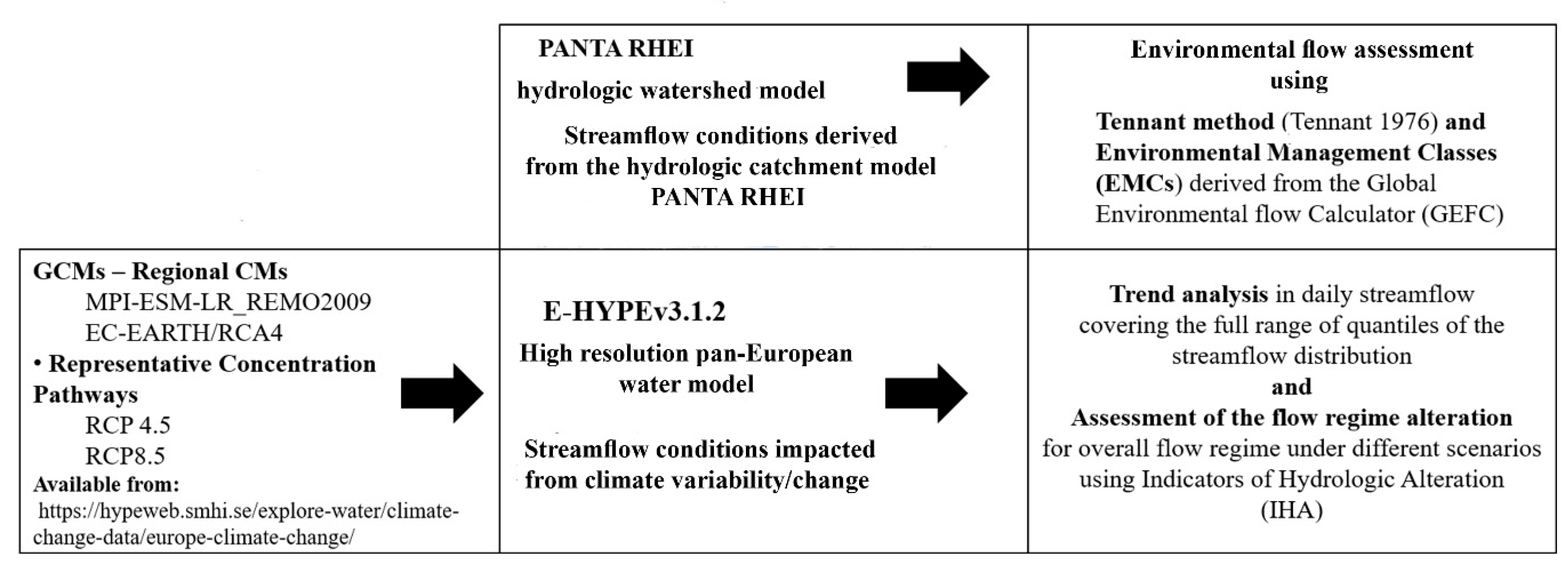

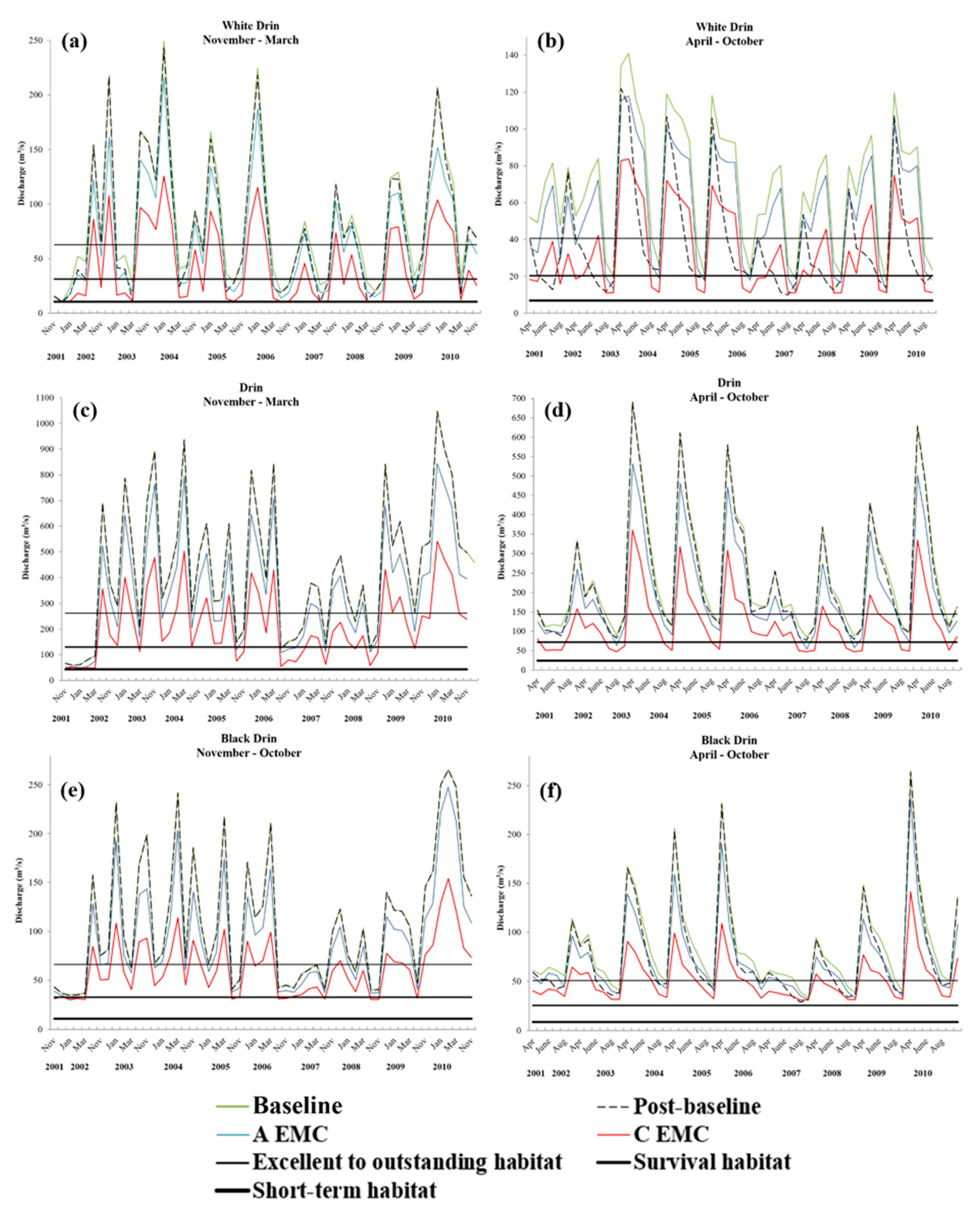
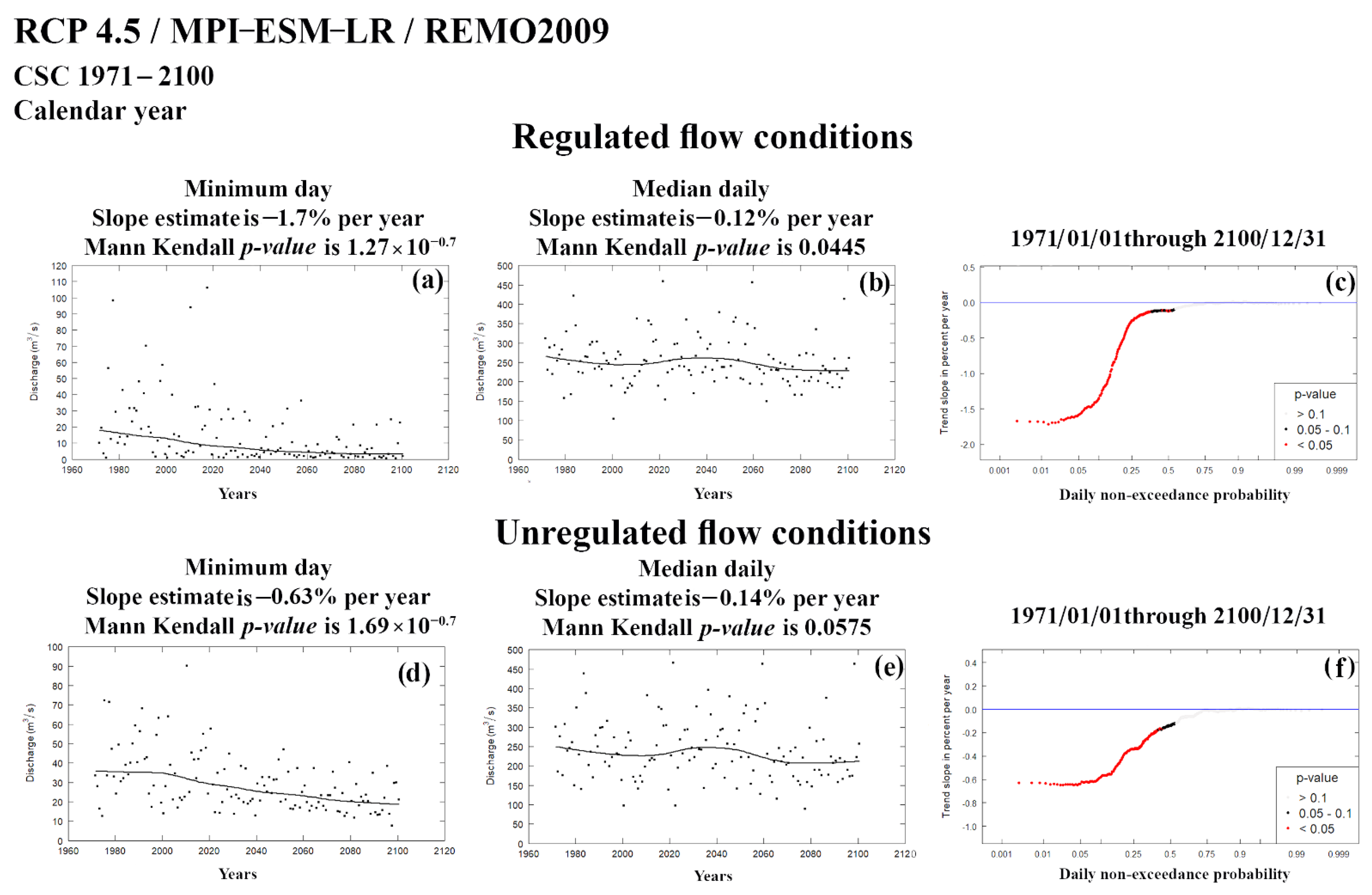
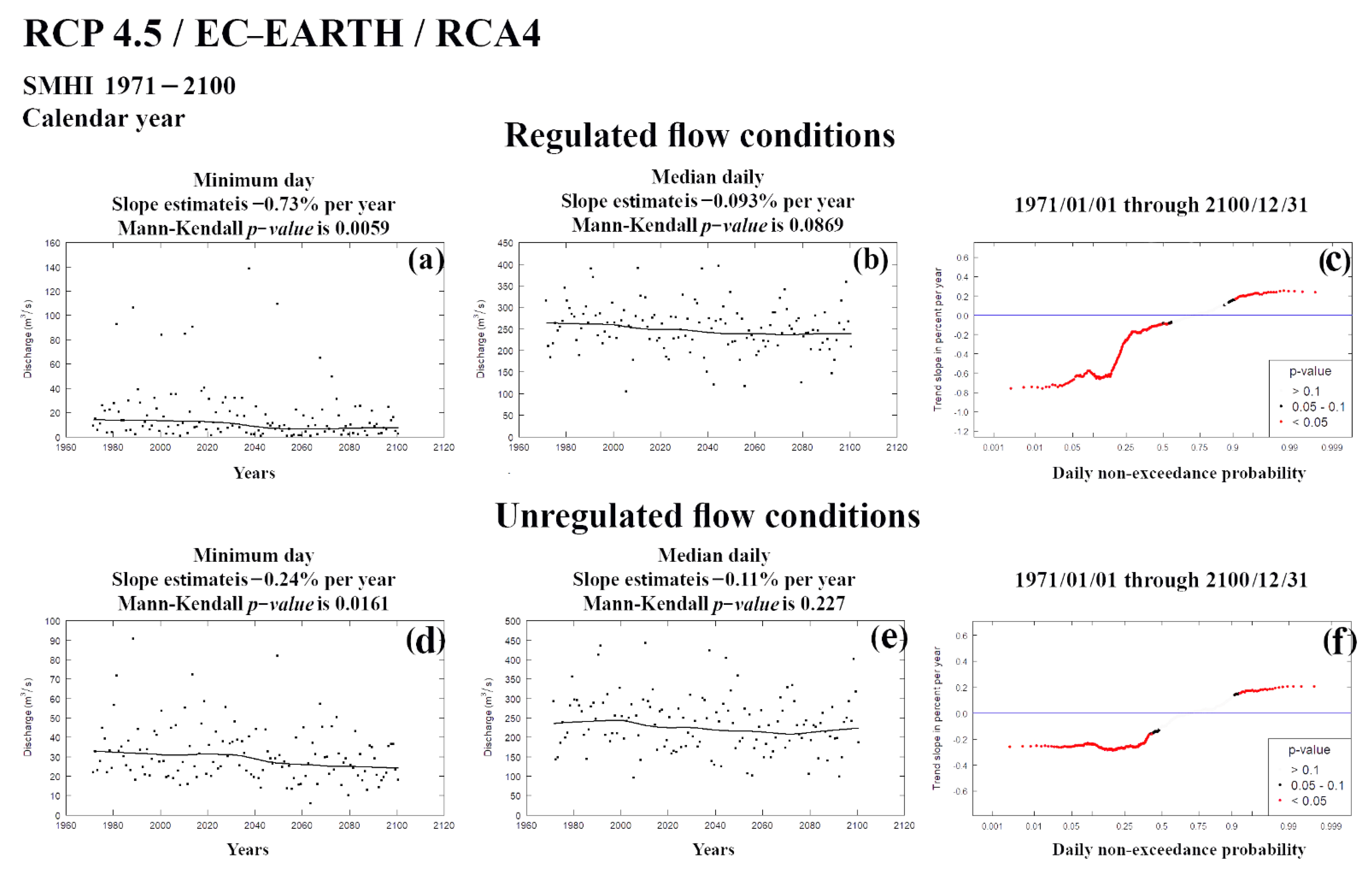
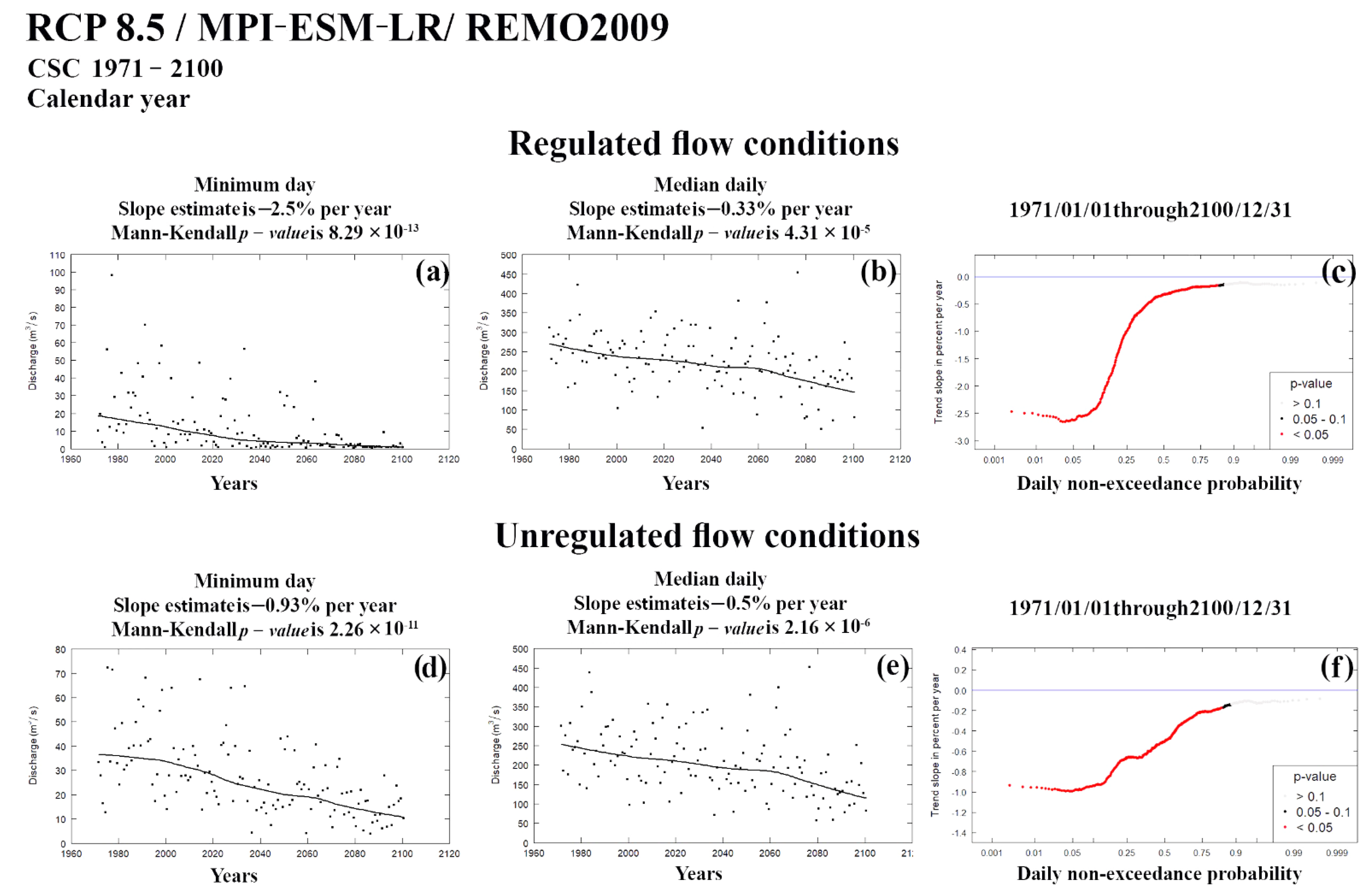
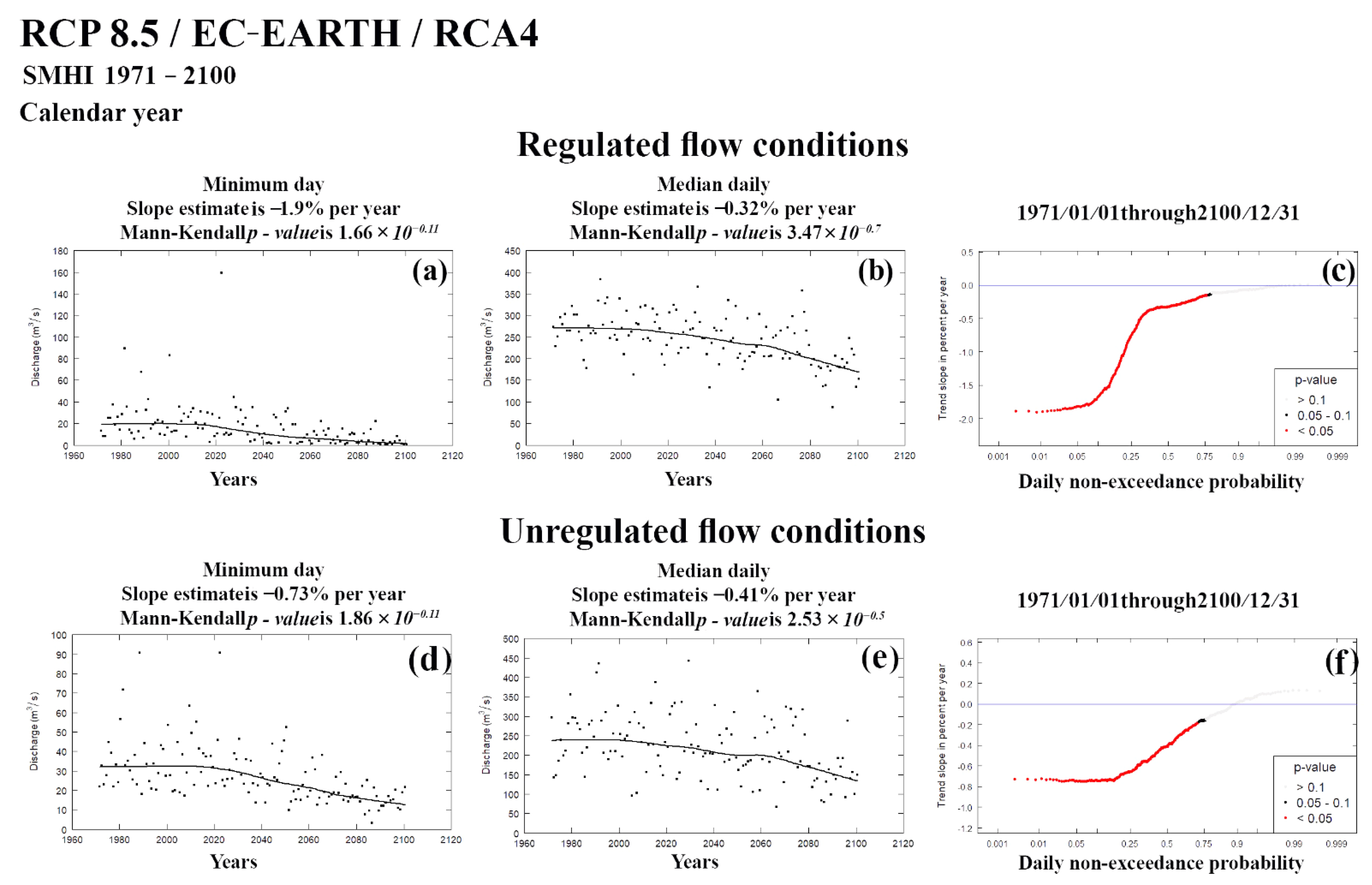
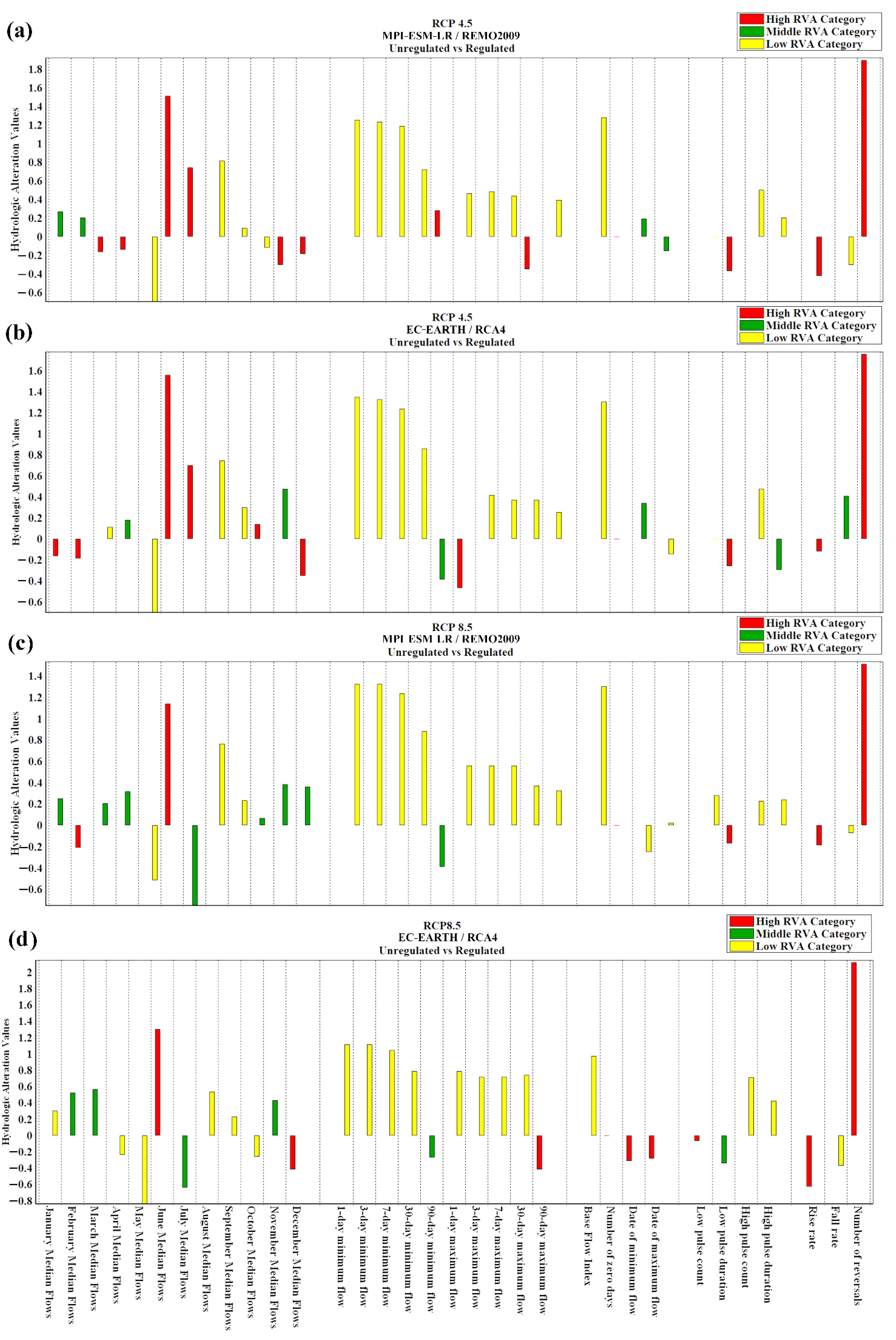
| Hydrological Model | RCP | GCM | RCM | Period | Institute |
|---|---|---|---|---|---|
| E HYPE version 3.1.2 | 4.5 | MPI−ESM−LR | REMO2009 | 1971–2100 | CSC |
| EC−EARTH | RCA4 | 1971–2100 | SMHI | ||
| 8.5 | MPI−ESM−LR | REMO2009 | 1971–2100 | CSC | |
| EC−EARTH | RCA4 | 1971–2100 | SMHI |
| EMC | Most Likely Ecological Condition | Management Perspective |
|---|---|---|
| A (natural) | Natural rivers with minor modification of instream and riparian habitat. | Protected rivers and basins; reserves and national parks; no new water projects (dams, diversions) allowed. |
| B (slightly modified) | Slightly modified and/or ecologically important rivers with largely intact biodiversity and habitats despite water resources development and/or basin modifications. | Water supply schemes or irrigation development present and/or allowed. |
| C (moderately modified) | The habitats and dynamics of the biota have been disturbed, but basic ecosystem functions are still intact; some sensitive species are lost and/or reduced in extent; alien species present | Multiple disturbances (e.g., dams, diversions, habitat modification, and reduced water quality) associated with the need for socioeconomic development. |
| D (largely modified) | Large changes in natural habitat, biota, and basic ecosystem functions have occurred; species richness is clearly lower than expected; much−lowered presence of intolerant species; alien species prevail. | Significant and clearly visible disturbances (including dams, diversions, transfers, habitat modification, and water quality degradation) associated with basin and water resources development. |
| E (seriously modified) | Habitat diversity and availability have declined; species richness is strikingly lower than expected; only tolerant species remain; indigenous species can no longer breed; alien species have invaded the ecosystem. | High human population density and extensive water resources exploitation; generally, this status should not be acceptable as a management goal; management interventions are necessary to restore flow pattern and to ‘‘move’’ a river to a higher management category. |
| F (Critically modified) | Modifications have reached a critical level; the ecosystem has been completely modified with an almost total loss of natural habitat and biota; in the worst case, basic ecosystem functions have been destroyed and changes are irreversible. | This status is not acceptable from the management perspective; management interventions are necessary to restore flow pattern and river habitats. |
| Statistics | White Drin | Drin | Black Drin | Buna/Bojana | Shkodër/Skadar | Ohrid | ||||||
|---|---|---|---|---|---|---|---|---|---|---|---|---|
| Flow (m3/s) | Bas | Post−Bas | Bas | Post−Bas | Bas | Post−Bas | Bas | Post−Bas | Bas | Post−Bas | Bas | Post−Bas |
| Min | 11.0 | 10.0 | 60.0 | 59.7 | 33.0 | 28.9 | 124.6 | 122.4 | 41.5 | 39.2 | 12.2 | 12.0 |
| Max | 272.8 | 272.1 | 1047.5 | 1047.1 | 265.8 | 265.3 | 2158.3 | 2158.2 | 1063.8 | 1062.9 | 30.6 | 21.2 |
| Mean | 84.6 | 68.8 | 337.9 | 332.6 | 97.5 | 93.0 | 656.0 | 653.6 | 314.4 | 306.6 | 19.6 | 17.2 |
| Median | 79.1 | 41.7 | 268.1 | 265.1 | 76.3 | 66.6 | 514.4 | 514.4 | 227.5 | 206.7 | 19.2 | 17.0 |
| CV | 0.7 | 0.9 | 0.7 | 0.7 | 0.6 | 0.7 | 0.7 | 0.7 | 0.7 | 0.8 | 0.2 | 0.1 |
| STD | 56.2 | 60.7 | 236.0 | 238.8 | 59.5 | 61.3 | 469.8 | 471.1 | 231.2 | 236.0 | 4.0 | 2.4 |
| Subbasin | Description of Flows | October–March | April–September |
|---|---|---|---|
| High Flows (m3/s) | Low Flows (m3/s) | ||
| White Drin | Short−term habitat | 10.5 | 6.8 |
| Survival habitat | 31.4 | 20.4 | |
| Excellent to outstanding habitat | 62.9 | 40.7 | |
| Drin | Short−term habitat | 43.5 | 24.0 |
| Survival habitat | 130.5 | 72.0 | |
| Excellent to outstanding habitat | 261.0 | 144.0 | |
| Black Drin | Short−term habitat | 11.0 | 8.5 |
| Survival habitat | 33.1 | 25.4 | |
| Excellent to outstanding habitat | 66.2 | 50.8 | |
| Buna/Bojana | Short−term habitat | 87.7 | 43.3 |
| Survival habitat | 263.0 | 130.0 | |
| Excellent to outstanding habitat | 526.1 | 260.0 | |
| Ohrid | Short−term habitat | 1.7 | 2.2 |
| Survival habitat | 5.2 | 6.6 | |
| Excellent to outstanding habitat | 10.4 | 13.1 | |
| Shkodër/Skadar | Short−term habitat | 42.9 | 19.9 |
| Survival habitat | 128.6 | 59.8 | |
| Excellent to outstanding habitat | 257.2 | 119.6 |
| Regulated | Unregulated | |||
| RCP 4.5 | REMO2009/ | RCA4/ | REMO2009/ | RCA4/ |
| MPIESMLR | ECEARTH | MPIESMLR | ECEARTH | |
| Min | 0.8 | 0.8 | 12.7 | 15.2 |
| Max | 2099.7 | 1428.8 | 2131.5 | 1643.6 |
| P 10 | 50.8 | 39.3 | 57.1 | 48.4 |
| P 90 | 525.7 | 525.7 | 578.1 | 588 |
| Mean | 278 | 283.8 | 283.1 | 288.4 |
| Med | 249 | 261 | 231.4 | 246.3 |
| CV | 0.7 | 0.7 | 0.8 | 0.8 |
| STD | 199.6 | 197.2 | 224.5 | 223.3 |
| Zer | 0 | 0 | 0 | 0 |
| Regulated | Unregulated | |||
| RCP 8.5 | REMO2009/ | RCA4/ | REMO2009/ | RCA4/ |
| MPIESMLR | ECEARTH | MPIESMLR | ECEARTH | |
| Min | 0.8 | 2.7 | 12.7 | 17.1 |
| Max | 2099.7 | 1937.5 | 2131.5 | 2311.7 |
| P 10 | 44.8 | 48.6 | 52 | 50 |
| P 90 | 515.1 | 499.5 | 565.9 | 574.1 |
| Mean | 272.3 | 277.5 | 277.5 | 281.9 |
| Med | 244.3 | 261.6 | 227.6 | 236.2 |
| CV | 0.8 | 0.6 | 0.8 | 0.8 |
| STD | 205.1 | 176.8 | 230.8 | 222.8 |
| Zer | 0 | 0 | 0 | 0 |
| Combinations RCP/GCM–RCM | Regulated | Unregulated | ||
| RCP 4.5 | REMO2009/MPIESMLR | RCA4/ECEARTH | REMO2009/MPIESMLR | RCA4/ECEARTH |
| Min daily | Statistically significant trends (Decreasing) | Statistically significant trends (Decreasing) | Statistically significant trends (Decreasing) | Significant trend at least at the alpha level of 0.1 |
| Med daily | Statistically significant trends (Decreasing) | no statistical significance | Statistically significant trends (Decreasing) | Significant trend at least at the alpha level of 0.1 |
| Regulated | Unregulated | |||
| RCP 8.5 | REMO2009/MPIESMLR | RCA4/ECEARTH | REMO2009/MPIESMLR | RCA4/ECEARTH |
| Min daily | Statistically significant trends (Decreasing) | Statistically significant trends (Decreasing) | Decreasing | Statistically significant trends (Decreasing) |
| Med daily | Statistically significant trends (Decreasing) | Statistically significant trends (Decreasing) | Statistically significant trends (Decreasing) | Statistically significant trends (Decreasing) |
Publisher’s Note: MDPI stays neutral with regard to jurisdictional claims in published maps and institutional affiliations. |
© 2021 by the authors. Licensee MDPI, Basel, Switzerland. This article is an open access article distributed under the terms and conditions of the Creative Commons Attribution (CC BY) license (http://creativecommons.org/licenses/by/4.0/).
Share and Cite
Papadaki, C.; Dimitriou, E. River Flow Alterations Caused by Intense Anthropogenic Uses and Future Climate Variability Implications in the Balkans. Hydrology 2021, 8, 7. https://doi.org/10.3390/hydrology8010007
Papadaki C, Dimitriou E. River Flow Alterations Caused by Intense Anthropogenic Uses and Future Climate Variability Implications in the Balkans. Hydrology. 2021; 8(1):7. https://doi.org/10.3390/hydrology8010007
Chicago/Turabian StylePapadaki, Christina, and Elias Dimitriou. 2021. "River Flow Alterations Caused by Intense Anthropogenic Uses and Future Climate Variability Implications in the Balkans" Hydrology 8, no. 1: 7. https://doi.org/10.3390/hydrology8010007
APA StylePapadaki, C., & Dimitriou, E. (2021). River Flow Alterations Caused by Intense Anthropogenic Uses and Future Climate Variability Implications in the Balkans. Hydrology, 8(1), 7. https://doi.org/10.3390/hydrology8010007






